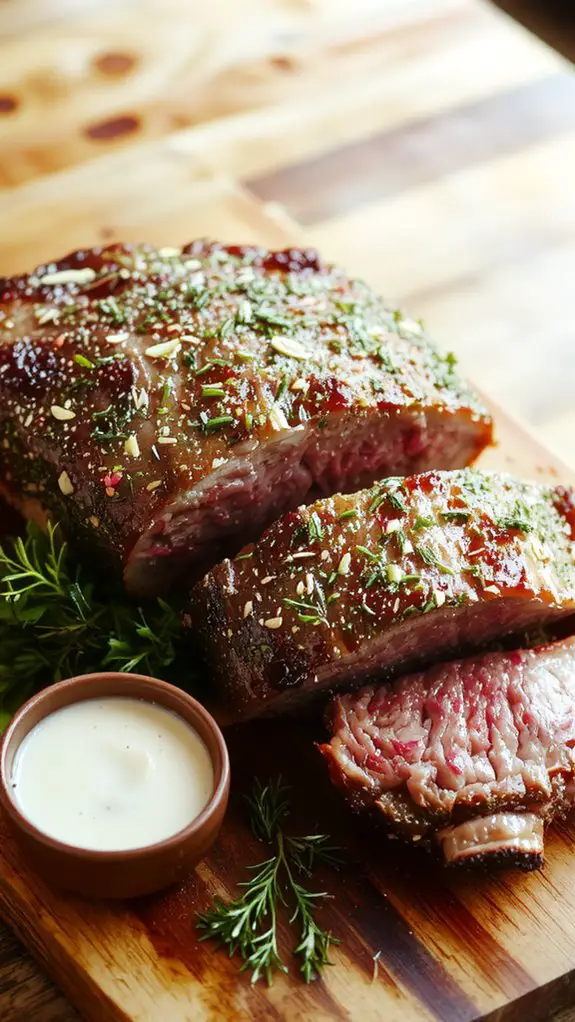I’ve spent years perfecting the art of making a prime rib roast that’s tender, juicy, and packed with flavor. It all starts with a quality cut and the right blend of seasoning, but the real secret lies in the technique. From properly bringing the meat to room temperature to mastering the slow-roasting process, every detail matters. If you’re keen to elevate your holiday or special occasion meal, there’s more to uncover about this standout dish.
Recipe
This prime rib roast is the kind of dish that will make you feel like a gourmet chef without breaking a sweat—I promise. It’s all about simplicity and letting the quality of the ingredients shine.
Starting with a bone-in rib roast, a generous rub of garlic, herbs, and butter, and a slow, even roast in the oven, this recipe delivers a tender, juicy, perfectly medium-rare centerpiece every single time.
The hardest part? Waiting for it to rest while the aroma of rosemary, garlic, and savory beef fills your kitchen. Trust me, the first slice, with its crispy, golden crust and melt-in-your-mouth interior, is worth every second.
Whether it’s a holiday feast or a Sunday dinner, this prime rib will have everyone reaching for seconds—and asking for your secret.
Ingredients
For a show-stopping prime rib roast, the right ingredients are essential. Start with a high-quality cut of meat—this is the star of the dish, so don’t skimp. Enhance its natural flavor with a simple yet robust seasoning blend, and don’t forget the finishing touches like a flavorful au jus or chimichurri if you’re feeling adventurous. Here’s everything you’ll need:
- Prime rib roast (bone-in or boneless): A bone-in roast adds extra flavor, but boneless works if you prefer easier carving. Aim for USDA Prime or Choice grade for the best results.
- Kosher salt: Coarse grain helps create a delicious crust.
- Black pepper: Freshly ground for maximum aroma.
- Garlic cloves: Fresh is non-negotiable—its pungent flavor is vital.
- Fresh rosemary and thyme: These herbs infuse the meat with earthy, aromatic notes.
- Olive oil or avocado oil: Helps the seasoning adhere and promotes browning.
- Unsalted butter: Optional, but slathering it on the roast before roasting adds richness.
For the au jus (optional but highly recommended):
- Beef broth or stock: Use low-sodium to control the saltiness.
- Red wine: Adds depth—cabernet or merlot works well.
- Shallots or onions: Sautéed to build a flavorful base.
For substitutions, avocado oil can replace olive oil, and dried herbs can work if fresh ones aren’t available (use 1/3 the amount). Don’t skip the garlic or kosher salt—they’re critical for flavor. A bit of butter on top of the roast before roasting? That’s the chef’s secret for a golden, irresistible crust.
How to Make the Best Perfect Prime Rib Roast

Rest the roast: Once the prime rib reaches the desired temperature, remove it from the oven and tent it loosely with foil.
Let it rest for at least 20-30 minutes. Resting allows the juices to redistribute, ensuring a moist and tender roast.
Carve and serve: Slice the roast against the grain for maximum tenderness. Serve with au jus, horseradish cream, or your favorite sides.
Pro Tip: For an extra layer of flavor, create a herb crust by mixing minced garlic, rosemary, thyme, and a bit of olive oil, then spreading it over the roast before cooking.
Watch Out: Avoid overcooking—use a meat thermometer to prevent drying out the roast.
Also, don’t skip the resting step; it’s essential for a juicy result.
Nutrition
Prime rib roast is a rich and indulgent dish, offering a hearty meal with a robust nutritional profile. Below is the nutritional breakdown per serving based on a typical recipe.
| Calories | Protein | Fat | Carbs | Cholesterol | Sodium |
|---|---|---|---|---|---|
| 450 | 35g | 32g | 2g | 95mg | 400mg |
Chef Tips
When preparing a prime rib roast, I always make sure to bring the meat to room temperature before cooking—it guarantees even cooking throughout.
I season generously with salt, pepper, and herbs, letting it sit for at least an hour.
Using a meat thermometer is essential; I aim for 120°F for rare or 130°F for medium-rare.
Rest the roast for 20 minutes before slicing—it locks in the juices.






